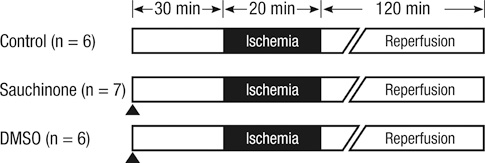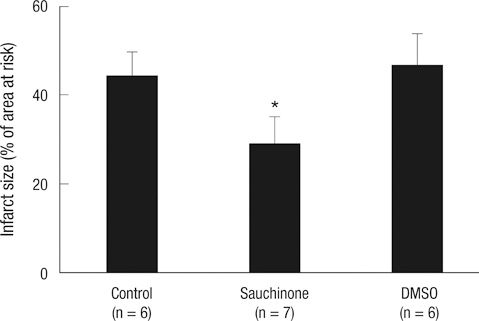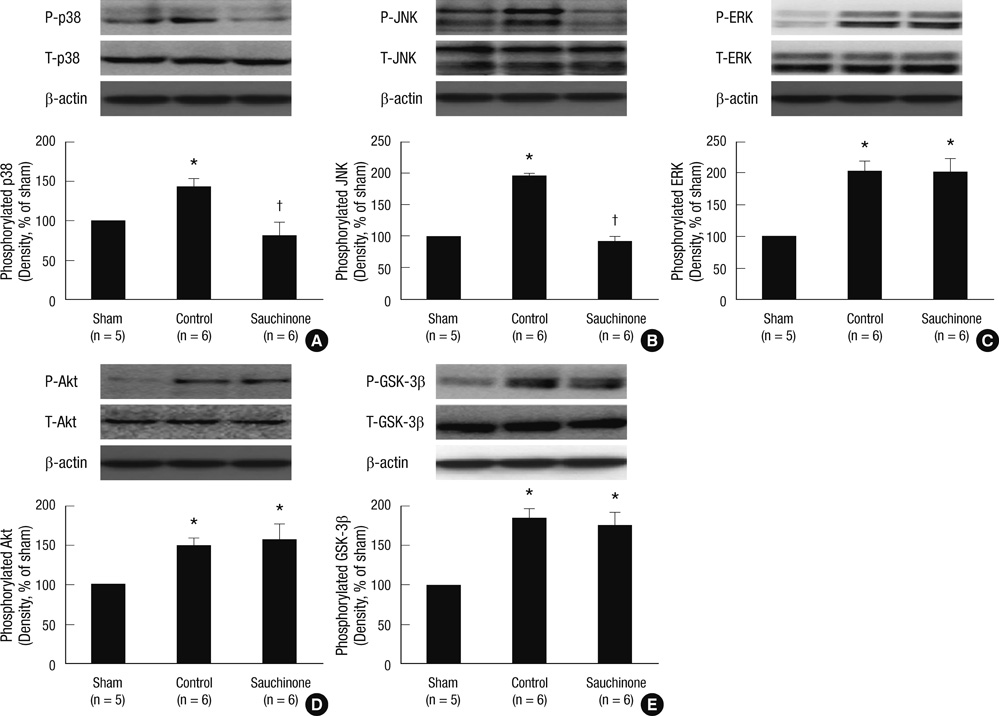J Korean Med Sci.
2012 May;27(5):572-575. 10.3346/jkms.2012.27.5.572.
Protective Effect of Sauchinone Against Regional Myocardial Ischemia/Reperfusion Injury: Inhibition of p38 MAPK and JNK Death Signaling Pathways
- Affiliations
-
- 1Department of Anesthesiology and Pain Medicine, Chonnam National University Medical School, Gwangju, Korea. kyyoo@jnu.ac.kr
- 2College of Pharmacy, Yeungnam University, Gyongsan, Korea.
- 3Korea Institute of Oriental Medicine, Daejeon, Korea.
- 4Department of Physiology, Chonnam National University Medical School, Gwangju, Korea.
- KMID: 1372805
- DOI: http://doi.org/10.3346/jkms.2012.27.5.572
Abstract
- Sauchinone has been known to have anti-inflammatory and antioxidant effects. We determined whether sauchinone is beneficial in regional myocardial ischemia/reperfusion (I/R) injury. Rats were subjected to 20 min occlusion of the left anterior descending coronary artery, followed by 2 hr reperfusion. Sauchinone (10 mg/kg) was administered intraperitoneally 30 min before the onset of ischemia. The infarct size was measured 2 hr after resuming the perfusion. The expression of cell death kinases (p38 and JNK) and reperfusion injury salvage kinases (phosphatidylinositol-3-OH kinases-Akt, extra-cellular signal-regulated kinases [ERK1/2])/glycogen synthase kinase (GSK)-3beta was determined 5 min after resuming the perfusion. Sauchinone significantly reduced the infarct size (29.0% +/- 5.3% in the sauchinone group vs 44.4% +/- 6.1% in the control, P < 0.05). Accordingly, the phosphorylation of JNK and p38 was significantly attenuated, while that of ERK1/2, Akt and GSK-3beta was not affected. It is suggested that sauchinone protects against regional myocardial I/R injury through inhibition of phosphorylation of p38 and JNK death signaling pathways.
Keyword
MeSH Terms
-
Animals
Benzopyrans/*pharmacology
Dioxoles/*pharmacology
Glycogen Synthase Kinase 3/metabolism
JNK Mitogen-Activated Protein Kinases/*metabolism
Mitogen-Activated Protein Kinase 1/metabolism
Mitogen-Activated Protein Kinase 3/metabolism
Myocardial Reperfusion Injury/*metabolism/pathology/prevention & control
Phosphorylation
Protective Agents/*pharmacology
Rats
Signal Transduction/*drug effects
p38 Mitogen-Activated Protein Kinases/*metabolism
Figure
Reference
-
1. Vinten-Johansen J. Involvement of neutrophils in the pathogenesis of lethal myocardial reperfusion injury. Cardiovasc Res. 2004. 61:481–497.2. Hausenloy DJ, Yellon DM. New directions for protecting the heart against ischaemia-reperfusion injury: targeting the Reperfusion Injury Salvage Kinase (RISK)-pathway. Cardiovasc Res. 2004. 61:448–460.3. Yin T, Sandhu G, Wolfgang CD, Burrier A, Webb RL, Rigel DF, Hai T, Whelan J. Tissue-specific pattern of stress kinase activation in ischemic/reperfused heart and kidney. J Biol Chem. 1997. 272:19943–19950.4. Yue TL, Wang C, Gu JL, Ma XL, Kumar S, Lee JC, Feuerstein GZ, Thomas H, Maleeff B, Ohlstein EH. Inhibition of extracellular signal-regulated kinase enhances ischemia/Reoxygenation-induced apoptosis in cultured cardiac myocytes and exaggerates reperfusion injury in isolated perfused heart. Circ Res. 2000. 86:692–699.5. Sung SH, Kim YC. Hepatoprotective diastereomeric lignans from Saururus chinensis herbs. J Nat Prod. 2000. 63:1019–1021.6. Song H, Kim YC, Moon A. Sauchinone, a lignan from Saururus chinensis, inhibits staurosporine-induced apoptosis in C6 rat glioma cells. Biol Pharm Bull. 2003. 26:1428–1430.7. Choi IY, Yan H, Park YK, Kim WK. Sauchinone reduces oxygen-glucose deprivation-evoked neuronal cell death via suppression of intracellular radical production. Arch Pharm Res. 2009. 32:1599–1606.8. Bae HB, Li M, Son JK, Seo CS, Chung SH, Kim SJ, Jeong CW, Lee HG, Kim W, Park HC, et al. Sauchinone, a lignan from Saururus chinensis, reduces tumor necrosis factor-alpha production through the inhibition of c-raf/MEK1/2/ERK 1/2 pathway activation. Int Immunopharmacol. 2010. 10:1022–1028.9. Kim SJ, Yoo KY, Jeong CW, Kim WM, Lee HK, Bae HB, Kwak SH, Li M, Lee J. Urinary trypsin inhibitors afford cardioprotective effects through activation of PI3K-Akt and ERK signal transduction and inhibition of p38 MAPK and JNK. Cardiology. 2009. 114:264–270.10. Seo CS, Lee YK, Kim YJ, Jung JS, Jahng Y, Chang HW, Song DK, Son JK. Protective effect of lignans against sepsis from the roots of Saururus chinensis. Biol Pharm Bull. 2008. 31:523–526.11. Song DK, Jang Y, Kim JH, Chun KJ, Lee D, Xu Z. Polyphenol (-)-epigallocatechin gallate during ischemia limits infarct size via mitochondrial K(ATP) channel activation in isolated rat hearts. J Korean Med Sci. 2010. 25:380–386.12. Srivastava S, Weitzmann MN, Cenci S, Ross FP, Adler S, Pacifici R. Estrogen decreases TNF gene expression by blocking JNK activity and the resulting production of c-Jun and JunD. J Clin Invest. 1999. 104:503–513.13. Mackay K, Mochly-Rosen D. An inhibitor of p38 mitogen-activated protein kinase protects neonatal cardiac myocytes from ischemia. J Biol Chem. 1999. 274:6272–6279.14. Li Z, Ma JY, Kerr I, Chakravarty S, Dugar S, Schreiner G, Protter AA. Selective inhibition of p38α MAPK improves cardiac function and reduces myocardial apoptosis in rat model of myocardial injury. Am J Physiol Heart Circ Physiol. 2006. 291:H1972–H1977.15. Ferrandi C, Ballerio R, Gaillard P, Giachetti C, Carboni S, Vitte PA, Gotteland JP, Cirillo R. Inhibition of c-Jun N-terminal kinase decreases cardiomyocyte apoptosis and infarct size after myocardial ischemia and reperfusion in anaesthetized rats. Br J Pharmacol. 2004. 142:953–960.16. Milano G, Morel S, Bonny C, Samaja M, von Segesser LK, Nicod P, Vassalli G. A peptide inhibitor of c-Jun NH2-terminal kinase reduces myocardial ischemia-reperfusion injury and infarct size in vivo. Am J Physiol Heart Circ Physiol. 2007. 292:H1828–H1835.17. Weinbrenner C, Liu GS, Cohen MV, Downey JM. Phosphorylation of tyrosine 182 of p38 mitogen-activated protein kinase correlates with the protection of preconditioning in the rabbit heart. J Mol Cell Cardiol. 1997. 29:2383–2391.18. Dougherty CJ, Kubasiak LA, Prentice H, Andreka P, Bishopric NH, Webster KA. Activation of c-Jun N-terminal kinase promotes survival of cardiac myocytes after oxidative stress. Biochem J. 2002. 362:561–571.19. Nishihara M, Miura T, Miki T, Tanno M, Yano T, Naitoh K, Ohori K, Hotta H, Terashima Y, Shimamoto K. Modulation of the mitochondrial permeability transition pore complex in GSK-3beta-mediated myocardial protection. J Mol Cell Cardiol. 2007. 43:564–570.20. Kim YW, Lee SM, Shin SM, Hwang SJ, Brooks JS, Kang HE, Lee MG, Kim SC, Kim SG. Efficacy of sauchinone as a novel AMPK-activating lignan for preventing iron-induced oxidative stress and liver injury. Free Radic Biol Med. 2009. 47:1082–1092.
- Full Text Links
- Actions
-
Cited
- CITED
-
- Close
- Share
- Similar articles
-
- Dexmedetomidine alleviates blood-brain barrier disruption in rats after cerebral ischemia-reperfusion by suppressing JNK and p38 MAPK signaling
- Effect of Mild Hypothermia on the Mitogen Activated Protein Kinases in Experimental Stroke
- HMGB1 increases RAGE expression in vascular smooth muscle cells via ERK and p-38 MAPK-dependent pathways
- SP600125, a selective JNK inhibitor, aggravates hepatic ischemia-reperfusion injury
- Myocardial protective effect by ulinastatin via an anti-inflammatory response after regional ischemia/reperfusion injury in an in vivo rat heart model




